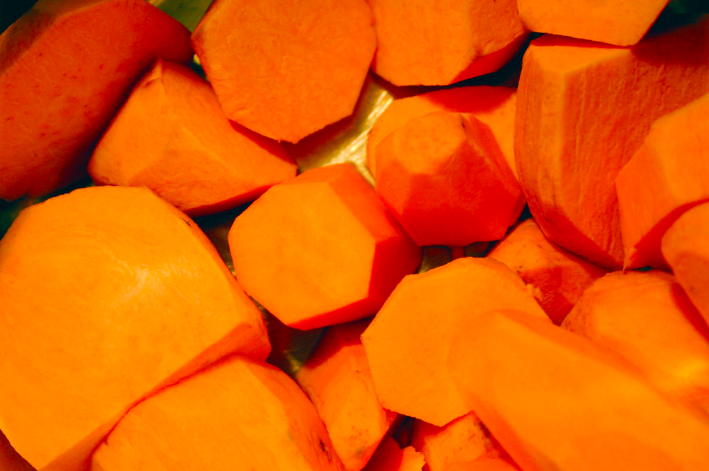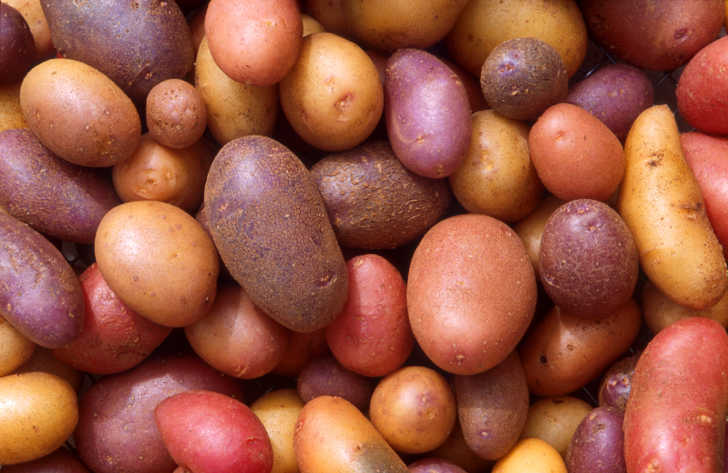Sweet potatoes and yams are basically twins within the root vegetable world. You’re not alone if you’ve got the two confused. They both have an oblong shape, coarse outer skins, and brownish color.
So, are they really that interchangeable or is there a difference?
In short, no. While they certainly seem similar to one another, yams and sweet potatoes are not the same. To be clear, sweet potatoes are sweet potatoes and yams are yams. While the two root vegetables may look similar to one another, that’s where their similarities end.
If you look a little closer, there are some subtle differences that you will notice between the two, and that can help you figure out which is which. And particularly if you’re concerned with calories, knowing the difference can be essential to your cooking.

Yams are originally from Africa and Asia. They have darker, brownish, and often has rougher external skin. On the inside, their flesh is a whiter shade and is drier in texture. Because of this dryness, yams can often require more oil, cream, or butter when cooking.
One of the biggest myths regarding the “sweet potato versus yams” debate, is that yams are more commonly sold in the US. But the truth is actually quite different. Most major groceries do NOT sell yams, but instead, are selling sweet potatoes and are just calling them yams. Mind-blowing, right?

While yams are grown all over the world as they can thrive in almost any climate if you’re looking for yams in North America your best bet would be to check out an international market or farmer’s market – since most major grocery chains will just sell sweet potato frauds. So, you may want to really rethink those candied “yams” at Thanksgiving this year.
However, if you do manage to get real authentic yams then you’re in for a treat. Yams are a naturally sweet root, meaning that they are perfect for side dishes. They can be roasted or diced up into a hearty yam stew. Plus, they can also be candied with butter and brown sugar.
By comparison, the sweet potato has lighter skin, tapered ends, and the flesh is a light yellow to deep orange hue. There are actually two different types of sweet potatoes – the hard and soft varieties – which are dictated by the firmness of the vegetable.
Unlike yams, sweet potatoes are more fussy about where they can be grown. They don’t do well in cold climates, and will only thrive in warm, tropical areas.
Sweet potatoes were first introduced to the US decades ago. As you can infer from the name, they do have a naturally sweet taste to them as well. And they aren’t as dry inside as the yams, so sweet potatoes don’t require as much butter oil or cream in order to be cooked to enjoyment. They go great when baked and covered in a sweet maple glaze. And of course, they also make excellent fries.
Nutritionally, both yams and sweet potatoes have core differences, even though both do provide an amazing array of vitamins and minerals. Regardless, knowing the nutritional facts can help you make informed decisions when cooking.
Yams provide around 30% of your daily dose of Vitamin C as well as around 800 mg of potassium. Sweet potatoes can give you more than three times your daily Vitamin A content, and have around 330 mg of potassium. However, if you’re fixated with the number of calories you’re consuming, then sweet potatoes may be the better choice as they have 20% few calories than yams.

So you may be wondering what is being sold in grocery stores if the “yams” aren’t actually yams? Like we mentioned before, sweet potatoes come in two types: soft and firm. It seems that when the sweet potato first hit the US market, it was the firm variety that was being sold. Afterward, when the soft version hit stores, there needed to be a way to distinguish them. Since these “soft” sweet potatoes are very similar in resemblance to the yam, they began getting peddled as “yams.”
So that is the history of the sweet potato/yam grocery store fraud. Now how do you distinguish between a soft sweet potato and a yam? You just need to get in there and really take a close look at them, keeping the descriptions in mind. And maybe stay away from the big chain grocery stores.













